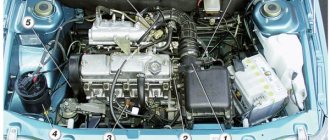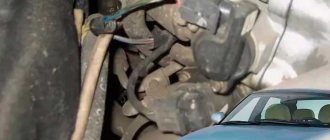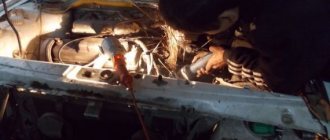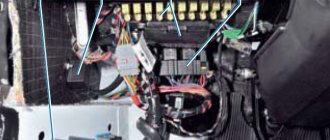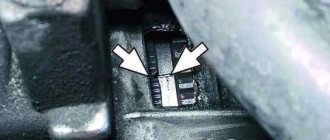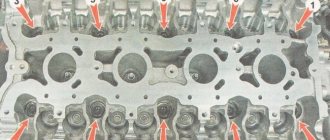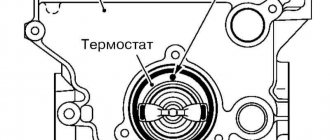In 1995, the Volzhsky Automobile Plant began production of a car, at that time a new generation VAZ-2110 with a sedan body.
Immediately, two more cars were produced on the basis of this model, with a station wagon body - VAZ 2111 and a hatchback - 2112.
Production of all three models continued until 2007.
The 10-series models belonged to the budget category of cars, which naturally affected the quality of materials and the car’s assembly itself, but in general, despite the questionable build quality, the car turned out to be in demand.
Historically, VAZ cars have never been famous for their reliability; this trend has not bypassed the 10th family either.
But it is worth noting that the maintainability of these machines is quite high; many problems are completely fixable, even in garage conditions. And the cost of spare parts is significantly lower than for foreign analogues.
Like any car, the VAZ-2110 and models based on it have weak points that you should first pay attention to during operation.
Next, we will go through all the components of the VAZ-2110, 2111, 2112 cars, with which problems most often arise, and at the end we will dwell on the reviews.
A little history
The VAZ 2110 was produced from the end of the 20th century until the middle of the first decade of the 21st century. During its existence, the top ten managed to gain a huge number of fans and underwent a large number of changes.
The tenth VAZ family was initially equipped with 8-valve carburetor engines that had common roots from the G8 engines. Time moved forward and AvtoVAZ needed to develop further, and at the end of the 90s, an injection engine was installed on the top ten for the first time, which was distinguished not only by a new injection system, but also by the number of valves; some new engines received a doubled number of valves from 8- mi to 16.
To operate an engine with an injection system, you need a huge number of different sensors responsible for the operation of the internal combustion engine, and the VAZ 2110 is no exception; the dozens of injection engines have many different sensors installed that ensure correct and smooth operation of the engine.
In this article we will talk about VAZ 2110-12 sensors, their symptoms of malfunction and installation locations.
Why do you need routine and major engine repairs?
As already mentioned, current repair work should be understood as the procedure for disassembling and assembling a vehicle engine with the subsequent replacement of some parts. Most often, replacements and upgrades require components such as:
- liners - main and connecting rod;
- piston rings;
- valve seals.
These replacements are a necessity, albeit periodic. They will not only increase engine resources, but also change the quality of its operation.
Mass air flow sensor (MAF)
It is one of the most important sensors. The mass air flow sensor is responsible for the formation of the air-fuel mixture. It measures the volume of air supplied to the intake receiver and transmits the readings to the electronic engine control unit, which in turn supplies the right amount of fuel in relation to air. The failure of this sensor affects many different functions of the internal combustion engine.
It should be noted that the “CheckEngine” lamp will light up only if the sensor fails completely. Most often, the sensor undergoes aging, but very rarely fails completely. You can read how to check this sensor in our article.
Signs of malfunction:
- Increased fuel consumption;
- Uneven idle speed;
- Difficulty starting the internal combustion engine;
- Loss of dynamics;
- Jerks when moving;
Speed sensor
This sensor is designed to transmit readings to the engine ECU about the speed of the vehicle. It is involved in adjusting the engine speed when driving, namely, if the car is rolling in neutral, you will notice that the speed is slightly higher than the idle speed when the car is standing still. The DS is also responsible for the performance of the speedometer and odometer.
Signs of malfunction:
- Inoperative speedometer or odometer;
- There are no increased speeds when driving in neutral gear;
Causes of “triple tripping” of a VAZ car engine
- Incorrect ignition timing
- Air leak in the vacuum brake booster system
- Spark plug fault
- High voltage wire breakdown
- Capacitor failure
- Loss of tightness in the intake manifold area (intake manifold, carburetor)
- Burnout of valve, piston
- Broken piston rings
- Incorrect valve adjustment
- Destruction and wear of rockers (valve levers)
- Cylinder head gasket failure
- Wear, hardening, destruction of valve stem seals
- Very low fuel quality
- Incorrect carburetor adjustment
- Wear of distributor shaft, rotary plate bearing
- Loss of tightness of the membrane of the vacuum ignition advancer
- I do not take into account the use of spark plugs that are not suitable for the engine and other “faults”.
Perhaps not all the reasons, but what I could remember, if you have anything to add, then write in the comments.
Important!
You can determine a bad cylinder using a simple, old and reliable method - one by one removing the high-voltage wire from the spark plug. You have to be very careful here, because you can get electrocuted! To carry out this manipulation more safely, you need to stand on a dielectric (rubber, wood), take a clean, dry rag, remove it by the wire, and not by the cap, and do not touch the car body at this time. It is very easy to check; use a choke to increase the idle speed to 1500 rpm and remove the caps from the spark plugs one by one. If the speed drops when the cap is removed, then the cylinder is working; if there is no difference, then the cylinder is not working.
Well, now let's talk about each of the reasons in more detail.
Thanks for subscribing!
- Incorrect ignition timing. With this option, I personally know not a tripping, but a seemingly slamming of the engine (missing), which is accompanied by “bouncing” of the entire engine. This is especially noticeable at idle; as the speed increases, the skips disappear. Most likely, your ignition is set too early; this may also be indicated by jerky cranking of the engine by the starter when starting.
- Quite often, the cause of engine tripping in a VAZ of all models (except for the VAZ 2101, which does not have a vacuum brake booster) is a loss of tightness in the hose, diaphragm, or valve. As a result, excess air appears in the intake manifold, which leads to over-leaning of the mixture and misignition of the mixture in the cylinder, as a result of which the spark plug may become wet and stop igniting the compressed mixture.
- A faulty spark plug is one of the most common causes of engine misfiring. There is nothing special to tell here, it is important to remember and replace spark plugs regularly, and the presence of a spark on an inverted spark plug at atmospheric pressure does not indicate its full functionality, because ignition occurs under much more difficult conditions (Za Rulem magazine, dating back to Soviet times).
- At this point I will combine the breakdown of the high-voltage wire and the capacitor on the contact ignition system. A wire breakdown can be determined by replacing all the wires, as well as the capacitor. You can also try to determine the breakdown of the wire by looking at them in complete darkness; if there is a breakdown somewhere, you will see flashes.
- Loss of tightness in the collector area, as a rule, does not occur on its own. More often this happens due to incorrect assembly or bad gaskets. I also had a case where they complained about trimming at idle. The reason was the elimination of the vacuum ignition advancer and the unplugged vacuum tube on the carburetor.
- As a rule, when a piston or valve burns out, the cylinder stops working altogether or does not work for a long time. It can only be determined by measuring compression and opening the engine.
- Breakage or sticking of piston rings is also not a very common occurrence, because a number of conditions are necessary for its occurrence. You can check it by measuring the compression; if it turns out to be low, then eliminate cylinder head malfunctions in a simple way - pour a little oil into the cylinder; if the compression increases, then there is a malfunction in the piston system.
- With incorrect valve adjustment, everything is already clear - any valve may not open or close completely. Proper valve adjustment can cure this problem. Rocker wear can cause a similar problem. The valve stops opening correctly and the cylinder stops working.
- Well, now let’s briefly go over the problems that may arise with the distributor. Quite often, on not new machines, wear of both the shaft itself and the bushings in which it rotates occurs, as a result of which it becomes impossible to establish an adequate gap between the contacts. The same thing happens if the swing plate bearing is worn out. Also, misfires can occur due to depressurization in the vacuum ignition timing advancer, where the membrane may fail.
Here I have written a few reasons why a VAZ engine may be tripping, if you want to notice or ask something, write below in the comments!
One of the most common questions from owners of domestic cars, VAZ 2112 injector 16 valves. This is quite common. Moreover, there may be several reasons, and finding them is quite difficult. At a minimum, you need to know where to look for the problem. If you ask any motorist about the reasons for this phenomenon, you can hear a variety of advice. But often they are all one-sided. And you need to approach the search purposefully, checking all possible options. Only then will you be able to reliably find the fault and fix it. First, decide on the symptoms of “motor tripping”...
They consist in unstable operation of the engine, and it usually rattles like a decrepit Cossack. This is especially noticeable on four-cylinder units. You can also notice pronounced vibration in the engine compartment. The smell of gasoline is often felt in the cabin, and fuel consumption becomes significantly higher.
Coolant temperature sensor (DTOZH)
The DTOZH is installed in the thermostat housing and transmits readings to the ECU about the temperature of the engine coolant. Based on these readings, the engine control unit increases or decreases engine speed for more stable operation of the internal combustion engine. The operation of this sensor is noticeable on a cold engine; when starting the engine in the cold season, you can notice increased speed, which decreases over time as the engine warms up to operating temperature.
Signs of malfunction:
- Increased fuel consumption;
- Poor starting on a cold engine;
- Lack of warm-up speeds;
Eliminating the causes of engine tripping
If the VAZ 2110 injector continues to misfire the engine with insufficient spark current or its absence, then the reason for this situation is the following defects:
1. Faults in high voltage wires - increased resistance of the product or a break. It is necessary to test these products with a multimeter connected; if measurements indicate a malfunction, they need to be replaced. 2. Suspicion of a defect in the “bobbin” - check and replace if necessary. 3. The on-board computer is not working correctly - diagnostics and troubleshooting are required. 4. The engine crankshaft position sensor produces incorrect data - eliminate the error that occurs; if this is not possible, replace the device with a new device. 5. The position of the timing belt has changed - install it in the correct position, adjust and install the shafts and gears according to the risks.
If there are sparks and working spark plug elements, we continue to look for what is causing the engine to stall and the traction to disappear. Other reasons may include:
- problems with compression;
- defective piston rings;
- clogged nozzles;
- loose contact of the valves with the seat on the cylinder head;
- unadjusted valves.
In practice, there are situations when the engine in a VAZ 2110 only stalls on a cold engine or on an “engine” that has reached the optimal operating temperature. In this situation, the main problem is the valves, or rather, their adjustment, which must be carried out after 20,000 km. The reason for this phenomenon on a cold engine is an increased valve clearance, which decreases after the power plant warms up.
The situation with warm engines is similar, but diametrically opposite. When the unit is cold, the valves have a normal clearance, and after warming up, due to the expansion of the metal, the valves are clamped, the cylinder does not function, and the engine speed begins to float, which causes the effect of incorrect operation of the power plant.
Many car enthusiasts and owners of a VAZ 2110 with an eight-valve engine encountered the fact that the engine began to trip. Of course, the majority immediately went to a car service center, where after short and simple operations everything returned to normal. In this article, we will look at the main reasons why the problem occurs and ways to solve it at home.
Crankshaft position sensor (CPS)
DPKV is a sensor that counts crankshaft revolutions. Just like most sensors, it participates in the formation of the fuel mixture. If it malfunctions, the car will not start.
The sensor is installed on the rear of the engine under the oil filter. Works in tandem with the crankshaft pulley (generator drive).
Signs of malfunction:
- The car does not start (no spark);
- Jerks when moving;
- Spontaneous engine stop;
Phase sensor (PF)
This sensor is necessary for counting camshaft revolutions; its functions are similar to those of the DPKV. Designed for phased fuel injection; without this sensor, the internal combustion engine will operate in emergency mode and the fuel supply will switch to pairwise mode.
It is installed under the timing cover on 16-valve engines, and on 8-valve engines on the end of the cylinder head on top of the thermostat.
Signs of malfunction:
- Increased fuel consumption;
- Unstable work at XX;
- Loss of dynamics;
Idle air control (IAC)
This sensor is installed on the throttle valve and regulates the air supply when the car is running at idle. In other operating modes of the internal combustion engine, the idle air regulator is not involved. The sensor performs mechanical functions, so if it malfunctions, the “CheckEngine” warning light does not light up.
If the regulator breaks down, you can wash it and try installing it again. If washing does not help, the sensor must be replaced with a new one.
Signs of malfunction:
- Unstable idle;
- The engine stalls when coasting;
- Difficulty starting the engine;
- Low speed XX;
VAZ 2110 will not start: car behavior options
So, let’s assume that an engine with an injector or carburetor does not start. This may be due to a malfunction:
- battery;
- fuel pump;
- spark plugs;
- crankshaft, camshaft sensors;
- fuel distribution system;
- ignition unit;
- alarm (if available).
In general, there are a lot of options, so we will look into it in more detail. And we will start with the condition of the car in which it refuses to start.
Doesn't start when the engine is warm
So, the injection engines of some VAZ models can give poor starting when hot. In this case, motorists replace the fuel pump, buy heat shields, install new fuel pressure regulators, and ignition modules. If these measures do not help, the reason lies elsewhere. And, first of all, it needs to be found out. But more on that later.
A cold engine will not start
During the colder months of the year, the car sometimes has difficulty starting. If the “ten” is left overnight in an open space, then its engine cools down quite significantly. The physical properties of metal, fuel, and lubricant also change at subzero temperatures. This leads to the fact that the VAZ 2110 does not start, but it’s worth trying to directly close the starter and the engine will start.
On a note! Sometimes a car may not start due to a discharged battery.
The engine starts and stalls
If the VAZ 2110 starts and stalls, then the reason could also be any: from a clogged valve in the gas distribution system to burnt relay contacts in the fuel pump.
Throttle Position Sensor (TPS)
TPS is designed to transmit indications about the position of the valve in the throttle assembly. The received readings are transmitted to the ECU for further regulation of the fuel mixture. This sensor fails quite often. Located on the throttle valve above the IAC.
The sensor cannot be repaired and if it breaks, it is replaced with a new one.
Signs of malfunction:
- Spontaneous increase and decrease in speed;
- Difficulty starting the engine;
- Increased fuel consumption;
- Low speed XX;
Oil pressure sensor (OP)
This sensor signals the condition of the oil pressure in the engine. When it decreases, a lamp on the car’s dashboard lights up in the form of a red oil can. The sensor is completely mechanical and is only responsible for turning on the low oil pressure indicator.
Signs of malfunction:
- The oil pressure lamp does not light up;
- The oil pressure lamp is constantly on;
Oxygen sensor (OS)
The VAZ 2110 oxygen sensor is installed in the exhaust manifold. The DC measures the exhaust gases and uses their readings to determine the ratio in which the fuel mixture is formed. If the readings exceed the permissible values, the ECU adjusts the air-fuel mixture in such an amount that the exhaust gases do not exceed the permissible values.
Signs of malfunction:
- Increased fuel consumption;
- Loss of vehicle dynamics;
- Black smoke when driving at high speeds;
General diagram of the injector operation
So:
- there is a so-called group of information sensors, which is carried out exclusively by data collection;
- all information goes to the controller, which is the analytical center of the injection system;
- depending on a number of factors, the controller sends an electrical pulse of a certain length directly to the nozzles themselves, which open for a strictly specified time period;
- The efficiency of the cylinders and, consequently, the engine itself depends on how much fuel and air are supplied from the injectors.
Note. A certain amount of air corresponds to a certain amount of fuel (if this ratio is violated, then the engine power will correspondingly decrease significantly).
VAZ 2110 injector relay diagram
The price of an injector (see VAZ 2110: flushing the injector on your own) is a flexible concept and depends on a number of components. However, the cost of fixing an injector problem at a car service center is very significant. The DIY repair instructions allow you to fix the problem, but you need to have a good understanding of the injector circuit. Photos and videos - materials in this matter will become the most valuable practical assistant.
Add a commentAdd a comment We advise you to read VAZ 2109 injector, the electrical diagram will allow you to connect additional optionsVAZ 2112: we fix the injector malfunction ourselves The injector error light is on VAZ 2110: what does it meanVAZ 2110: replacing the injector thermostat on your own
An injection engine is superior to a carburetor engine in many respects. However, it has a weak point - the injector can quickly become clogged when using low-quality dirty gasoline and is more difficult to diagnose and repair.

